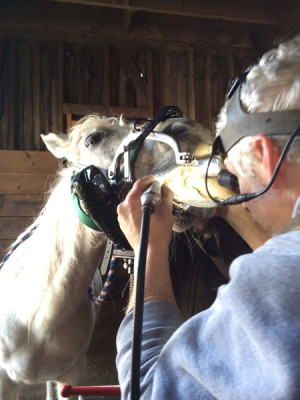Nutrition: Dental Visit #3 Case Study Elegance CF 2001gm
Elegance had her third dental visit and second power tool dental procedure on March 1, 2016. She was ready for another adjustment as I saw her starting to avoid the long stem hay and searching for the fine stuff that falls out during their selecting what hay to eat. Also, washing her mouth out every 3 or 4 days showed more packing between her left upper dental arcade and her cheek. My equine dentist sent me a mouth washing tool, bless his heart. What is used is called a “drencher” for sheep and cattle if you care to look up what those look like.
Here is what her mouth looks like after he finished.
Please note how “short” her right side lower molars are. This is from years of over grinding on the right side. What he told both myself and my veterinarian, who was present for the special sedation she needs for this type of dentistry, is he isn’t trying to make both sides of her mouth look the same. He is balancing each side to itself. The two sides will never look “equal”. He said if this problem had been caught when she was young it could have been corrected. But now we go for the most movement on the left side we can get.
When he began the remodeling Elegance could not slide her lower jaw forward when her head was dropped below the horizontal level or slide her lower jaw back when her head was raised above the horizontal. She now has some movement both forward and backward. Think about the implications of not being able to relax her lower jaw and slide it as necessary when being ridden, especially with a bit.
Here is a picture of what it looks like when he is working on her.


Jeannie: This is hugely important! I was wondering if any research has been done on feral horses to see if they develop the crookedness of teeth as they age. Maybe they don’t live long enough for that to happen.
Also if straightening a horse is the foundation principle of all finer forms of riding is it a possibility that The Classical high school training- lateral; work and movements were developed as a means of addressing crookedness which has manifested here as dental issues.
best wishes
Bruce Peek
Hi Bruce. I do not know of any studies which followed feral horses from birth to old age with regards to their teeth. Would be interesting to know though wouldn’t it?!
Elegance is only 15 this year. Hard to say exactly when things went wrong in her dentition. The process of developing the malocclusion Elegance has likely began shortly after her permanent molars erupted. This notion is based on how short her right lower molars are at this age. My dentist and others will tell you dental health is an essential aspect of good performance by the horse.